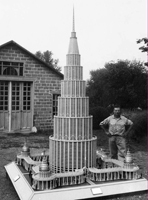
The Encyclopedic Palace is thetitle chosen by the director for the 55th International Art Exhibition of the Venice Biennale. It evokes the design deposited in 1955 with the US Patent office by the self-taught artist Marino Auriti, depicting an imaginary museum that was meant to house all worldly knowledge, bringing together the greatest discoveries of the human race, from the wheel to the satellite.
Auriti’s plan was never carried out, but the dream of a universal, all-embracing knowledge crops up throughout history, shared by other eccentrics (among them artists, writers, scientists, and prophets) who tried to fashion an image of the orld that would capture its infinite variety and richness.
These personal cosmologies, with their delusions of omniscience, shed light on the constant challenge of reconciling the self with the universe, the subjective with the collective, the specific with the general, the individual with the culture of his time.
Today, as we grapple with a flood of information, such attempts to structure knowledge into all-inclusive systems seem even more necessary and even more desperate.The aim of the 55th International Art Exhibition is to explore these flights of the imagination in a show that—like Auriti’s Encyclopedic Palace—combines works of contemporary art with historical artefacts and found objects.